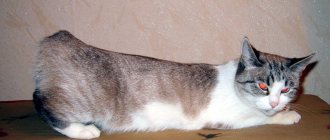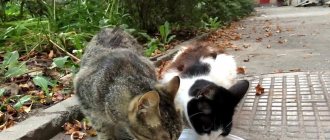What will you learn from the article?
- When do cats go into heat?
- How long does a cat's heat last?
- As often happens
- Signs and symptoms
- How do cats go into heat?
- How to help a cat in heat
- Drugs for estrus Drops, tablets and suspensions for festivities
- Why should you get sterilized?
Estrus in cats is a period of sexual arousal. Like other mammals, these periods occur when they become sexually mature and ready to reproduce.
In this article you will learn everything about this condition and understand the best way to deal with your animal.
At what age does the first heat occur?
The speed of puberty depends on many factors. The onset of a cat's first heat is influenced by:
- Heredity. The tendency to experience early puberty is passed on to offspring from parents.
- Season of birth. A kitten that was born in the summer matures faster than its “winter” counterparts. In such a female, estrus can begin for the first time at 5-7 months.
- Animal breed. In large individuals, estrus occurs later than in miniature ones. Short-haired animals mature earlier than long-haired ones. Thus, estrus in British cats and representatives of the Scottish Fold breed begins at 8-12 months. But Orientals and Abyssinians mature by 5 months. In Ragdolls, Maine Coons, Siberian and Norwegian Forest cats, estrus may first begin at the age of 9-15 months.
- Lifestyle. Pedigree domestic cats mature longer than their homeless street counterparts.
- Having problems with weight. Individuals that are too fat or emaciated mature later than females with normal body weight.
- Light level. In a pet living in a darkened room, the activity of sex hormones is suppressed and the rut occurs later.
- The presence of other cats in the house. Living in the same territory with other individuals stimulates the early manifestation of sexual instincts.
Signs and symptoms
Determining heat in cats is quite simple. You need to pay attention to the following signs:
- The animal's genitals are enlarged, there is no bloody discharge, but there is a clear, generally light discharge that the cat can inherit.
- Your pet will lick itself more often, and urination may become more frequent than usual.
- Sometimes there are disturbances in appetite - the cat eats less often and less.
- Cats become more affectionate, rubbing against everything they can - furniture, owners. They also roll around on the floor and squirm. There are, of course, individuals who, on the contrary, become too aggressive during the period of heat.
- The animal tries to escape from the house, using all possible entrances and exits - windows, doors, etc.
- The animal makes plaintive, drawn-out and sometimes very loud sounds, thus calling cats.
- He bends his posture, lies down on the floor, actively tramples his hind legs and moves his tail to the side.
How to understand that a cat has gone on a spree
You can tell that a cat is in heat by a number of characteristic signs:
- The cat begins to insistently demand attention. She becomes very affectionate and even intrusive. But sometimes attacks of tenderness give way to aggression, and then even the calmest cat turns into a hissing and biting fury.
- When stroking the pelvic area, the cat takes a characteristic pose. She arches her back and lifts her hindquarters up, her tail retracted and her front legs extended. This position is a sure sign that the cat is in heat and is ready to mate with a male cat.
- The cat's behavior changes a lot. She begins to actively rub against any objects, including walls, furniture and even her owner’s feet. In this way, she spreads her own scent to attract males.
- The most unpleasant of all the signs of heat in cats is the leaving of marks. The female turns her back to a vertical surface and, raising her tail, secretes a few drops of urine.
- To attract males, a cat begins to scream loudly during estrus. Moreover, it does not calm down even at night, and this causes inconvenience not only to the owners, but also to the residents of neighboring apartments.
- When a domestic cat goes into heat, her urge to escape increases, even if the animal has never been outside.
- You can find out that the female has begun to estrus by a decreased or missing appetite. These days she eats less than usual or refuses food altogether.
Keeping your cat healthy
What to do if your cat is in heat? Cats can have a very difficult time with the sexual cycle, and sterilization in this case has many advantages. For example, sterilization helps prevent the development of ovarian and uterine cancer in cats.
According to the College of Veterinary Medicine at Cornell University, it is recommended that your cat be spayed before she goes into her first heat. A spaying procedure performed at a veterinary clinic involves the removal of a cat's reproductive organs so that she will no longer have an estrous cycle (that is, she will no longer be in heat) and will no longer be able to become pregnant. Because pets can become pregnant during their very first reproductive cycle, it's important to neuter them to prevent cat populations from becoming too large, the American Society for the Prevention of Cruelty to Animals says. Kittens are cute, of course, but not all of them will find a loving home.
When you take a cat home, be sure to ask if it is sterilized. If you are unsure, consult your veterinarian during your fur baby's wellness checkup. We also recommend asking your veterinarian more about your cat's cycle and how you can stop it. While it may not be entirely clear how to behave during her estrous cycle, being informed and constantly caring for your cat is the best place to start.
Duration and frequency of sexual heat
On average, sexual heat occurs once a quarter. But in some animals it can be repeated every 3 weeks, in others - only a couple of times a year. As often happens, estrus in cats depends on many factors:
- Variety. In Persian, Siamese and Oriental cats, estrus occurs more often than in representatives of the Scottish and British breeds. In the latter, the frequency of estrus can be 5-8 months.
- Age. In young animals, symptoms of estrus recur more often than in older animals.
- Presence of pregnancy. Cat "periods" return to their original schedule 1.5-3 months after birth.
- Season. This dependence is clearly expressed in street individuals. From the beginning of spring to mid-autumn, the intervals are reduced due to the fact that during the warm period it is easier to bear and give birth to a healthy offspring. In winter there is a long break between heats.
- Number of matings. Infrequent matings help reduce the intervals between heats to 14 days. On the contrary, if matings are too frequent, the rut repeats up to 2 times a year.
On average, estrus in cats lasts 5-7 days, but sometimes its duration increases to 14-20 days.
Important! If heat lasts less than 5 days or lasts longer than 3 weeks, the animal must be shown to a veterinarian. Too short a heat may indicate the presence of ovarian hypoplasia or thyroid disease. Long-lasting sexual heat can be a symptom of inflammation of the ovaries or the development of neoplasms.
Proestrus
Preparatory phase, which lasts 1-4 days. It is accompanied by the first scanty discharge and changes in the cat’s behavior. The animal becomes more affectionate and often rolls on the floor. During this period, the cat is not yet ready to mate and will not let her partner in.
Estrus
The second stage, which lasts 5-10 days and is accompanied by the appearance of noticeable transparent discharge. During this period, the cat is not able to control its behavior. She constantly screams and takes a characteristic pose. It is during this period that mating occurs.
Metestrus
How this period goes depends on how the previous one ended. If it ended with mating, during which fertilization occurred, then after 60-70 days the offspring will be born. If there was mating, but fertilization did not take place, then a false pregnancy develops, which does not lead to childbirth and goes away after 30-45 days. If mating does not occur, then over the next 2-15 days the cat’s sexual activity fades away, and interest in the opposite sex is replaced by aggression.
Anestrus
The final stage that ends estrus in cats. It is called the rest period and lasts from 3 weeks to several months. At this time, the cat again appears balanced and behaves as usual.
What is a heat cycle?
The heat cycle is a more accurate way to describe a cat's reproductive cycle. This usually starts when she reaches six months of age, but depending on the breed it can be anywhere from four months to a year. During this time, the cat will be able to mate, ovulate and give birth to kittens.
She can be bred at any time in this cycle and may even have a litter of multiple males. Estrus can last from one day to a week. It will be another week or two before she goes into heat again. Environmental factors can influence the length of the breeding cycle.
Cats are ovulatory inducible, meaning that she will continually come and go until she is bred. If you don't want kittens, it's best to have her spayed.
Is it possible to calm a walking cat?
It is not enough to determine that a cat is in heat; you also need to understand what to do to calm the animal. To temporarily eliminate unwanted behavior, we recommend:
- Increase activity. The cat’s aggression and unspent activity should be redirected in another direction. The animal can be distracted by long, exhausting games, which consume energy and help normalize night sleep.
- Change feeding schedule. Because fertile cats lose their appetite, they should be fed little but often. But the evening portion needs to be increased so that the satiated animal sleeps at night.
- Give sedatives. To prevent the cat from experiencing stress, it is recommended to give it sedatives based on herbal preparations (Stop-stress or Cat Bayun).
Do cats menstruate?
In a word...no.
Of course they have a reproductive cycle. But this will not be associated with bleeding. This will involve constant howling, rolling, urinating, and the cat constantly raising his butt in the air with his tail up, but a cat's heat cycle does not include bleeding.
She may be noisy and a little annoying, but at least there's no blood to clean up!
© shutterstock
Hormonal drugs to interrupt sexual desire
Certain hormonal agents will help suppress or interrupt a cat's estrus. They act directly on the pituitary gland and lead to serious consequences. Such drugs do not stop the cycle, but temporarily delay it. They are not designed for frequent use and should be given no more than 1-2 times a year.
Constant use of such drugs leads to hormonal imbalances and the development of serious health problems. And the most dangerous thing is that negative changes appear after a long time and sometimes even one dose is enough to cause pathologies of the reproductive organs.
Sexual cycle in mammals
Women, like other female mammals, have sexual cycles (in women they occur monthly and are called “menstruation”), during which the lining of the uterus is “renewed” every 28–38 days (the length of the cycle is individual for everyone). The females of some other placental mammals (the orders bats, primates, and jumpers) exhibit similar cycles.
Other mammalian species of reproductive age also have cycles similar to menstruation, notes BBC Discover Wildlife. However, in them the “old” uterine mucosa dissolves and does not come out with blood. It is this reproductive process, which is called “estrus” or more often “estrus”, that occurs in a cat every month if she is not spayed. That is, spayed or neutered pets do not go into heat.
Cats are polyestrous animals, Animal Planet explains. This means that they come into heat several times a year. If a cat does not become pregnant, the sexual cycle will repeat until she is spayed - or until she becomes pregnant after mating. Also, all cats that have reached sexual maturity (that is, they have fully developed their entire reproductive system and are ready to give birth to offspring) need at least 12 hours of daylight for a normal sexual cycle. For example, in cats that constantly live in a cozy house or apartment with artificial lighting, hormonal activity occurs constantly, and not just for six months, Animal Planet notes. During the “hardest part” of the reproductive cycle, your pet is at the mercy of sex hormones that are “working at full capacity.”
Sterilization
This is the best and most effective method of preventing heat in cats that are not intended for breeding. Sterilization reduces the risk of developing diseases of the genitourinary system, increases life expectancy, eliminates behavioral problems and prevents unwanted pregnancy.
The only disadvantage of the operation is that it is performed under general anesthesia, which is stressful for the cat’s body. To avoid negative consequences, before sterilization, animals over 1.5 years old must be shown to a specialist who can prescribe a biochemical blood test and ultrasound of the heart.
Estrus in cats is a natural process that is accompanied by noticeable changes in behavior. During this period, animals are very sensitive, completely subordinate to instincts and need caring treatment.
What should I do if my cat is in heat?
There are only two real options here. You can just let her mate with the cat. (Not recommended as this will give you a litter of kittens in need of rehoming at best, or a sick, injured or dead cat at worst.)
Or you can further ensure that she does not approach male cats. Her howls and scents are sure to attract the attention of the local cats, so you may have trouble with a few gentleman callers who want to know if the cat can come out and play.
It's best to wait. The cat does not need any changes in its diet, but it could use some toys to relieve stress. Not those kinds of toys! Buy her something cheap that she can tear into pieces while working through her frustrations.
Something infused with catnip can help her forget about her problems. Of course, the simplest solution is to not deal with the cat at all when she's in heat. And this also lets us down….
How to calm a cat
Having figured out how to understand that a cat has gone into heat, it remains to figure out what to do if the owner does not want to endure constant nightly arias. There are only two cardinal solutions: pregnancy and sterilization. The operation not only suppresses sexual desire, but also prevents the development of cancer.
When choosing regular matings, unwanted behavior goes away only temporarily, so to calm your pet you will have to resort to medications, changes in activity and diet.
Change of activity and food
Aggression and increased activity can be directed towards toys. Long games use up increased energy reserves and normalize night sleep. Try to distract your pet during the daytime sleep to exhaust him by nightfall. Also, do not forget about increased attention. Talk and pet your pet more often. Your love will help reduce your stress levels.
Another trick to ensure long sleep is abundant feeding later in the day. Temporarily limit constant access to the feeder and give out food strictly on a schedule. After a night of feasting, all energy will be spent on digestion, and not on concerts.
Remember that with an increase in the evening portion, the volume of the daily ration remains unchanged. Otherwise, there is a risk of obesity. Meals should be small and easily digestible so as not to overload the gastrointestinal tract.
Sedatives
Veterinarians recommend sedatives made from herbal preparations (Cat Bayun, Stop-Stress). They are not addictive and do not have severe side effects. Their only contraindication is the presence of an allergy to one of the components.
Hormonal drugs
Taking hormonal medications (Stop-Intim, Sex-Barrier) is possible only as prescribed and under the supervision of a veterinarian. These medications directly affect hormonal levels, which can trigger the development of pathologies of the ovaries and uterus, including cancer.
With the constant use of hormones, 70% of animals endure forced sterilization for medical reasons. It is much safer to deprive your pet of reproductive function soon after puberty.
What not to do
Please note that traditional methods of calming are not only cruel and senseless, but also dangerous. Avoid raising your voice or using physical punishment. Compliance with this rule is the key to a strong and respectful relationship with any pet. Don’t try to judge your pet for nighttime insomnia and leaving marks - all this happens not out of malice, but under the influence of hormones.
Do not cool your genitals with ice water. This will not only frighten the animal, but can also cause inflammation.
Don't try to lock your pet in a dark room. The sun's rays do stimulate hormones, but staying in a confined space for a long time will only lead to mental disorders.
Can a spayed cat go into heat?
It all depends on the type of operation chosen. Most often, females are not sterilized, but castrated. These operations are often confused, suggesting that the latter is performed only on males. In fact, sterilization is a tubal ligation that prevents fertilization. A neutered female cat will not be able to give birth to kittens, but will still want to mate due to the influence of hormones.
Changes in hormonal levels can only be achieved by castration. The operation is divided into 2 types:
- oophorectomy, which involves removing the ovaries and preserving the uterus;
- ovariohysterectomy, which involves the removal of all reproductive organs.
The first method reduces the risk of developing polycystic disease and breast tumors, but does not protect against uterine cancer. For this reason, the second method is more reliable.
For simplicity, veterinarians may use the same terms as owners. Before the operation, be sure to discuss the purpose and method of surgery to avoid misunderstandings.
What an owner should do when a cat comes into heat for the first time
Pet owners who encounter heat for the first time usually do not know what to do in this case. You need to understand that this is physiology and there is no escape from it.
Experts highlight several tips that will be useful to cat owners:
- Mate with a cat. In this case, fertilization and further birth of kittens occurs. Therefore, a person must be prepared for such an outcome. In the first heat, mating is not recommended. The animal’s body is not yet ready to bear and feed offspring.
- Wait until the end of the heat and carry out sterilization. Surgical intervention by doctors should occur only 1.5-2 weeks after the end of estrus.
- Do not scold for non-standard behavior. It is impossible to scold an animal for actions that are unusual for it, and especially not to punish it. She cannot give up her nature and physiology on command and begin to obey.
- Distract and calm. To alleviate the pet's condition by distracting it with games and entertainment is considered the most preferable option.
- Reduce the amount of food. Since the cat’s appetite becomes noticeably less, it is better to reduce the amount of food given, but at the same time increase the number of feedings.
- To bathe. Giving your cat a warm bath with chamomile will relax the cat and allow it to go through heat faster. Especially if you then place it in a dimly lit room.
- Buy special medications. Veterinary pharmacies sell tablets and drops that relieve symptoms of estrus. They have a calming effect and will help you cope with an unpleasant period.
A good option is mating with an active cat that has undergone castration. In any case, before manipulation, it is better to consult a veterinarian.
1111
How to relieve a cat's condition
To make it easier for you and your cat to survive the difficult period of her estrus, follow these helpful tips:
- Distract with games - it is useful to stock up on new toys and invent new entertainment, preferably outdoor games. The more tired the cat is from playing during the day, the more peacefully the cat will sleep at night;
- Pay more attention - calm, caress the pet, pick it up more often so that the cat feels your support;
- Feed on a different schedule - a cat in heat has a decreased appetite, so reduce portions, but offer food more often.
It makes no sense to scold a cat for its physiological characteristics. The animal follows its nature and cannot voluntarily stop calling the cat and worrying. The best option is to be patient and get through this period.
Advice about taking your cat to the shower or locking it in the dark will not help ease or speed up the course of estrus. Sudden swimming will only cause stress, and staying in the dark will make you nervous and adversely affect the nervous system.
A radical option to stop estrus for a while is to breed a cat with a cat. But be prepared for the possible appearance of offspring.
How is a cat sterilized?
Usually the operation is performed after the first heat, before the formation of the reproductive system.
To undergo sterilization, you must make an appointment for surgery. Before this, the veterinarian will take all the necessary tests from you. Check the heart for pathologies. Once the doctor decides that the cat is healthy, he will schedule a day and time for surgery.
All necessary examinations are carried out to determine the dose and type of anesthesia that is suitable for a particular cat.
Veterinarians perform the operation in two ways:
Abdominal incision . It is done for adult cats and for complications when maximum access to organs is necessary.
Laparoscopic method . The operation is performed through a small hole. This intervention is less traumatic. The pet recovers faster after surgery.
Carry out sterilization only in trusted clinics. Experienced veterinarians and new equipment will help avoid critical situations during surgery. Also, large veterinary clinics do not give the pet back to the owner after surgery, but monitor his condition until he wakes up and all vital signs are normal.
Diagnosis
If, when examining a sick cat, the veterinarian finds blood, pus, urine or feces in abnormal quantities, the veterinarian will need to review the cat's medical history and conduct a risk assessment.
A thorough medical examination of the cat is required to make an accurate diagnosis.
Call a veterinarian Moscow
+7(495)162-70-70
- Blood tests
- General urine analysis
- Vaginoscopy
- Vaginal cytology
- Biopsy
- X-ray
- Ultrasound











